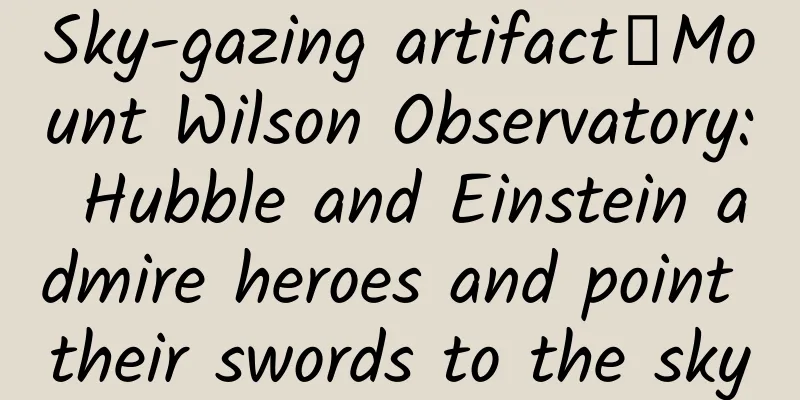Sky-gazing artifact丨Mount Wilson Observatory: Hubble and Einstein admire heroes and point their swords to the sky

|
Preface Starting today, I will start a new series of programs - "Observing the Sky with Magical Instruments" - a companion program to "Dreaming of Another World" that I broadcast last year. "Dreaming of Another World" was all about space probes, but this time I will take you back to Earth and tell you the stories of those ground-based observatories. It can be said that each ground-based observatory is a astronomical instrument. It is with the help of these magical instruments that humans have gradually unveiled the mysterious veil of the universe, allowing us to see countless amazing scenes. As these astronomical observatories gaze upon the universe, humanity's old view of the universe is constantly being refreshed. Each observatory is like a monument to human civilization, recording the story of a group of bipedal animals less than 2 meters tall exploring the vast universe on a blue planet in a corner of the Milky Way. Without further ado, let’s begin our story. Sky Observation Tool 01-Mt. Wilson Astronomy Original author: Liu Chen Editor: Wang Jie More important than a honeymoon One day in December 1930, in Berlin, Germany, it was midwinter and the north wind was howling. The famous physicist Einstein was newly married, but he had no time to enjoy the sweetness of his honeymoon with his wife. He had to go to California, USA immediately. Einstein went to California not for a honeymoon. In his opinion, there was something that had a much higher priority than a honeymoon. In the days when civil aviation was not yet popular, it was not an easy journey to travel from Germany to the United States on the other side of the earth. In order to reach California on the west coast of the United States, Einstein first took a train from Germany to Belgium, then took a ship at the Port of Antwerp, and crossed the Atlantic Ocean to New York, USA. After a short stay, Einstein took a ship south from New York, USA, along the east coast to the Panama Canal, then crossed the canal to the Pacific Ocean, and continued to go north along the Pacific Ocean. It took a month before he finally arrived in Los Angeles, California. This was Einstein's second visit to the United States and his first visit to the west coast of the United States. He came all the way to California on an academic visit invited by the California Institute of Technology. But for Einstein, there was another very important personal purpose, which was to visit a place and then meet a person. This place was the Mount Wilson Observatory in California, and the person he was going to visit was the legendary American astronomer Edwin Powell Hubble (1889-1953). The discovery made by Hubble at Mount Wilson Observatory not only refreshed Einstein's cognition, but also refreshed human's cognition of the universe. Mount Wilson Observatory also wrote a brilliant chapter in the history of human astronomy because of this discovery. In 1904, George Ellery Hale (1868-1938), an American astronomer known as the father of solar observation, came to Mount Wilson, northeast of Los Angeles, California. He immediately fell in love with this treasure land. Why? Because there is a relatively rare atmospheric phenomenon above the area where Mount Wilson is located, which is called the "inversion layer". Normally, the temperature decreases with the increase of altitude, but due to some complex causes, in some places, it is just the opposite, which is the inversion layer. One of the biggest benefits of the inversion layer is that the atmosphere is very stable. Mount Wilson is one of the areas with the most stable atmosphere in all of North America, which is particularly conducive to astronomical observations. After Hale discovered this treasure land, he immediately moved a world-leading astronomical telescope from Yerkes Observatory. In this way, the Mount Wilson Observatory was officially established. After the observatory was established, Hale led a scientific research team to observe and study the sun. It was here that he proved that sunspots are the center of the sun's strong magnetic field. This was also the first time that humans detected the magnetic field of a celestial body outside the earth. But soon, Hale felt that the aperture of the telescope was too small. For astronomers, the pursuit of the aperture of the telescope is endless, and no matter how big it is, it is not enough. Image: Haier But Hale was not only good at scientific research, he also had another talent, he was also good at soliciting sponsorship. He quickly persuaded local wealthy businessmen to donate money for the observatory. In 1908, Mount Wilson Observatory built the world's largest astronomical telescope at that time. With the world's most advanced telescope, Mount Wilson Observatory suddenly became a hot spot. Researchers from all over the world came here to observe the telescope, including the legendary astronomer Hubble. Hubble did research at Yerkes Observatory in his early years. Since Hale moved the telescope to Mount Wilson and built a new large telescope, he became a frequent visitor to Mount Wilson. Hubble was an energetic young man. Not only did he major in astronomy and mathematics at the University of Chicago, he also loved boxing. When he graduated from graduate school, he could choose astronomy or mathematics, or he could choose to become a professional boxer. Fortunately (from the perspective of an astronomy enthusiast like me), Hubble devoted himself to the field of astronomy. A photo that subverted the perception of the time When Hubble began to devote himself to astronomy, the mainstream view in academia was that the Milky Way was the entire universe, the size of the universe was the diameter of the Milky Way, and all celestial bodies were either close to the center of the Milky Way or, like our solar system, were located on a spiral arm of the Milky Way. However, there are some different opinions. In fact, as early as the 17th century, astronomers discovered a spiral nebula in the night sky. Today, every astronomy enthusiast knows that these nebulae are actually galaxies, but early astronomers could not easily imagine that these nebulae that look like snowflakes in the telescope are galaxies. After astronomers discovered that the shape of the Milky Way is spiral, some people began to wonder whether those spiral nebulae are also galaxies like the Milky Way? If this view is correct, it means that our universe is not just the Milky Way, but there are galaxies outside the Milky Way. This is equivalent to subverting the human view of the universe, which is a great event. But the problem is that extraordinary claims require extraordinary evidence. Bold conjectures alone are not enough. Scientific conclusions require evidence. History gave Hubble the important task of solving this problem. How to find evidence? This question troubled Hubble. The method Hubble used was spectral analysis. Every bright spot in the night sky, after being split by a grating device, will present a colorful spectrum. Hubble collected spectra from various nebulae as much as possible and made detailed analysis. He found that the spectrum of the Andromeda Nebula was very similar to that of the sun and had the properties of a star. In fact, as early as 1864, British astronomer Sir William Huggins (1824-1910) had made the same discovery, but the equipment at the time was relatively simple and the data was not solid enough. This time, Hale verified Hubble's data, and they were convinced that the Andromeda Nebula was composed of countless luminous stars. Hubble also used the super telescope at the Mount Wilson Observatory to take a picture of the Andromeda Nebula. The world's largest telescope at the time was completed, but the problem was not solved. Proving that the Andromeda Nebula is made of stars does not prove that it is another galaxy outside the Milky Way. Because the Milky Way contains a large number of star clusters, the discovery of star clusters is not a particularly significant discovery. For Hubble, figuring out the distance to the Andromeda Nebula was the key. But under the conditions at the time, it was almost impossible to determine how far a faint light point in the night sky was from the earth. The only promising way to solve this problem is to build a larger telescope, the bigger the better. So, Hale stepped up again, and his talent for attracting sponsors was once again demonstrated. He managed to invite the famous philanthropist, steel tycoon, and the world's second richest man at the time, Andrew Carnegie (1835-1919), to the Mount Wilson Observatory, and then gave him a good lecture on science. Finally, Carnegie was so excited that he readily agreed to donate 10 million US dollars, which was definitely an astronomical sum of money at the time. Figure: Carnegie (left) and Hale Popular science sometimes plays a key role in scientific research. This is why all scientific research institutions in the United States attach great importance to popular science, because money can be raised through popular science. In this way, with money, many things became easier to do. On November 1, 1917, the world's largest telescope was completed. The English poet Alfred Noyes (1880-1958) later wrote in his epic poem The Watcher in the Sky to mark this moment: ...explorers of the sky, pioneers of science, Now prepare to strike the darkness again, And win the new world. “… The explorers of the sky, the pioneers of science, now made ready to attack that darkness once again, and win new worlds." This telescope was the Hooker telescope which later became famous all over the world. Hubble's Law With it, Hubble was even more powerful and finally found a way to crack the distance to the Andromeda Nebula. In the night sky, there is a type of star called a "Cepheid variable star". It is a variable star whose brightness changes periodically. There is a fixed relationship between the absolute brightness of a Cepheid variable star and its period of brightness change, which means that this type of star can become the "standard candle" in the universe. The brightness of light is inversely proportional to the square of the distance. If the absolute brightness of a light source is known, then measuring the apparent brightness is equivalent to measuring the distance. Figure: Hubble's observation notes Hubble took a large number of photos of the Andromeda Nebula with the Super Hooker Telescope, from which he discovered 34 Cepheid variables. He then spent more than two years patiently drawing the light variation period curves of these Cepheid variables and calculated the absolute brightness of these Cepheid variables. Based on their apparent brightness in the telescope, the distance of these Cepheid variables can be calculated. His calculations showed that the Andromeda Nebula is about 930,000 light-years away from us (now we know that he still greatly underestimated the distance), far beyond the diameter of the Milky Way. The Andromeda Nebula is obviously not a member of our Milky Way. In 1925, Hubble announced this result at a conference of the American astronomical community, which caused a sensation. Hubble's data was extremely solid and the evidence was sufficient, and it was quickly recognized. He almost single-handedly expanded human knowledge of the universe. At this time, Hubble and Mount Wilson Observatory were famous and were the leaders in astronomical research. Hubble did not stop his research. He continued to point the Hooker telescope at those distant galaxies, and an even more amazing cosmic mystery was about to be discovered by him. After continuous tracking observation and calculation, Hubble found that almost all galaxies (except the Andromeda Galaxy) are moving away from us. This phenomenon is called galaxy recession. After calculating and summarizing the recession speeds of all galaxies, Hubble concluded that the ratio of a galaxy's recession speed to its distance is a constant. In other words, galaxies are moving away from us, and the farther away they are from us, the faster they are receding. This is the famous Hubble's Law. Heroes appreciate heroes There is really no other more reasonable explanation than the expansion of the universe. Once Hubble's conclusion was released, it was like poking a hornet's nest, and the entire astronomical community exploded. Today we all know that the theory of cosmic expansion has been recognized by the scientific community. However, at that time, the expansion of the universe was absolutely a shocking view. Einstein, who was far away on the other side of the earth, was also extremely shocked after hearing the news. He couldn't sit still and had to go to the United States to visit Hubble. Einstein's shock was justified. As early as 1916, when Einstein proposed the general theory of relativity, he found that the equations of general relativity led to a corollary that the universe is dynamic, either expanding or contracting, but the problem is that this corollary violates Einstein's intuition. Intuition and a simple view of the universe made Einstein firmly believe that the universe should be in a steady state and could not be large or small. There must be something missing in his equations. So, after much deliberation, he added a constant to the equations of general relativity, which is called the "cosmological constant" to maintain the steady state of the universe. Now, Hubble actually discovered that the universe was not in a steady state, but was expanding. This shocked Einstein greatly, and he had to visit Hubble in person to verify it. On the morning of January 29, 1931, the warm sea breeze of California blew away the winter chill. Hubble and his wife drove to pick up Einstein to visit the Mount Wilson Observatory as scheduled. On the way, Einstein said to Hubble's wife from the bottom of his heart: "Your husband's work is extremely outstanding." At the observatory, Einstein was like a child, unable to put down the huge telescope and lingered. When the staff introduced the telescope to Einstein, Einstein looked at Hubble, smiled and said to everyone: "Hubble confirmed my prediction with this telescope." Being accepted and recognized by Einstein made Mount Wilson Observatory and Hubble famous. Hubble won almost all the major awards in the scientific community except the Nobel Prize. Because in Hubble's time, the Nobel Prize had not been awarded to the field of astronomy, and the scientific community at that time did not regard physics and astronomy as the same scientific research field. Otherwise, Hubble's winning of the Nobel Prize in Physics would definitely be well deserved. end Hubble's achievements at Mount Wilson Observatory are monumental in the history of human understanding of the universe, and these achievements have forever written Hubble and Mount Wilson Observatory into the history of astronomy. If Hubble has opened a bright light for mankind to illuminate the universe and guide mankind in the right direction to explore the universe, then Mount Wilson Observatory is the beacon. (Photo: Have you found Hubble?) Mount Wilson Observatory has owned the world's most advanced astronomical telescope since its establishment. In 1969, in order to commemorate Hale, Mount Wilson Observatory and Palomar Observatory merged to form Hale Observatory. In 1986, the Hooker Telescope at Mount Wilson Observatory completed its historical mission and was officially decommissioned. In 1992, with the advancement of technology, an adaptive optics system was installed on the Mount Wilson Observatory telescope, which revitalized this outstanding warrior and reactivated it. In the following years, the telescope remained an important tool for astronomers around the world to explore the universe. To this day, Mount Wilson Observatory remains a well-known astronomical landmark, with tens of thousands of visitors coming every year to visit the observatory, which has led humanity to change its view of the universe, like a pilgrimage. I think the ultimate question that humans can ask is: What is the universe? No question is bigger than this one. In terms of scale, humans are so different from the universe that it is hard to describe them with any adjectives. But even though humans are so tiny in front of the universe, they can find a way to peek into the whole picture of the universe, which is really amazing. The legendary story left by Hubble at the Mount Wilson Observatory is the beginning of human civilization's understanding of the full picture of the universe. He made us deeply understand how science speaks with evidence. In the face of evidence, even a great scientist like Einstein must be convinced. Evidence is the premise of all answers. |
>>: Exploring the Mystery of World Sailing丨Be careful! There is a "sea monster" ahead
Recommend
Tailing's "I'm Open-Minded" theme event invites you to immerse yourself in stress relief and have fun with Tailing
On September 23, 2023, the 19th Asian Games opene...
Understand in one article: the basic framework of brand building
It may be that the market has recovered a lot in ...
Qiu Yuan-Victoria's Secret Body Shaping Private Lesson Video
The quality of the recorded video cannot be compa...
How can the medical beauty industry break through the three major operational difficulties?
As people's living standards rapidly improve,...
Alibaba's conspiracy and conspiracy to make up for the "Double 12"
The 50-yuan discount made offline stores crazy. T...
Taichi jailbreak v1.2.0 released to crack iOS 8.1.2 in half a day
This morning, Apple officially released iOS8.1.2 ...
What is the difference between Baidu and Google?
Recently, Baidu CEO Robin Li personally answered ...
Wanma Douyin Book List Matrix Project Video
Wanma’s Douyin book order number matrix project i...
Mycoplasma pneumoniae infection may peak in November: Parents must know these key questions
The health of children concerns every parent. Thi...
Search sitemap configuration in mini program
WeChat has now opened search within mini-programs...
Is iOS jailbreaking really necessary?
[[123533]] For an Apple fan, the word "jailb...
Proving Einstein wrong again! Scientists verify the famous Bell test in superconducting circuits for the first time
In 2022, three physicists were awarded the Nobel ...
FF is listed on the US stock market and will start mass production and delivery within 12 months. Jia Yueting: I must return to China!
On July 22, local time in the United States, Fara...
Where does the aroma of tea come from, including the tender fragrance, the hair fragrance, and the pine smoke fragrance?
The fragrance of plum blossoms comes from the bit...
The laser TV market is in a saddle-shaped decline, and how to break the situation has become an urgent matter
After years of rapid growth, it was thought that ...









